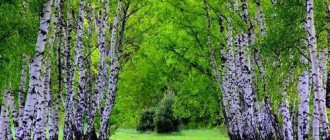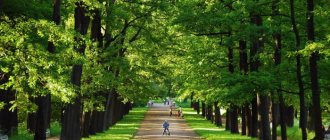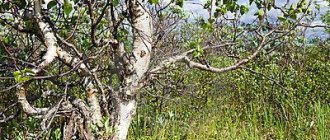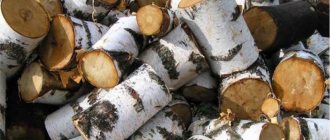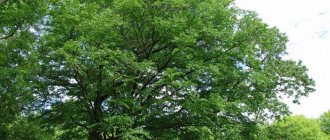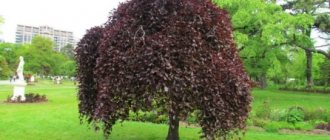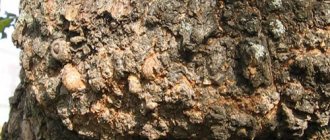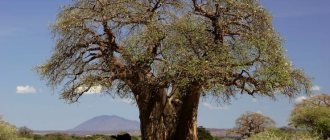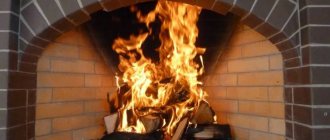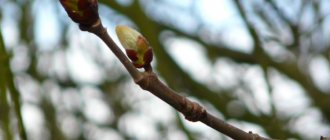Kinds
There are several types of birch trees (see photo) used in the national economy.
Hanging
At 8 years old, the tree reaches 30 m, the color of the trunk changes to white. The wood is considered one of the densest and heaviest.
The plant is also called warty birch: there is a lot of resin on the trunk. A young tree has straight branches, but in old age they droop downwards. The leaf shape is diamond-shaped. The flowers are brown. The most suitable place for the tree to live is mountainous or flat terrain. Life expectancy is up to 120 years.
The plant is used to make charcoal and plywood.
Dwarf
It resembles a branched shrub and grows in Canada and northern Russia.
Birch prefers mountainous or swampy areas. The leaves are small, their upper part is darker than the lower part. The bark is brown, the trunk is smooth, with a corky layer.
This fluffy birch grows slowly and is frost-resistant.
In the northern regions, the leaves are used as food for deer. The plant is well suited for landscape design.
Karelian
Grows in Karelia, Lithuania, and northwestern regions of Russia. It is characterized by an unusual growth on the trunk - kappa.
This is a subspecies of silver birch and includes three varieties:
- short,
- medium height,
- tall.
Because of its unique pattern, wood is used in the manufacture of sculptures and dishes. Karelian birch is a symbol of the north of Russia.
Rare species
Rarely found species:
- Daurian, or Korean, birch. The maximum height of the tree is 25 m. The leaves are oval, dark green. Growth requires a lot of light and moisture . The wood is used to make crafts and charcoal.
- Squat. Unusual fluffy birch shrub. Maximum height - 2.5 m. Grows in marshy areas of Western Siberia and the Far East. The oval leaves have resinous warts. Blooms in May. Used for the production of medicines and solid fuels.
- Iron or Schmidt birch. The wood of this plant does not burn and does not sink in water. Can be found on the rocks of China, Japan, and southern Primorye. Reaches 20 m, the crown starts from 8 m. The bark is dark gray and brown. Life expectancy sometimes exceeds 400 years. Birch loves light; if there is not enough light, the trunk bends. The tree is not used for commercial purposes.
- Red. It is distinguished by its unusual yellow-gray bark, small height, no more than 5 m. It grows in Kazakhstan. The tree is listed in the Red Book.
- Stone or Erman birch. Found in Sakhalin, Kamchatka, and Japan. Has brown bark. Height - about 20 m. The tree is frost-resistant, prefers rocky soil. Used for the production of coal, making crafts.
Description of the tree
Birch is one of the most common plants in our country. There are about a hundred species of birch trees, growing not only in Russia, but also in the forests of North America and throughout Europe. All varieties of birch trees can be divided into two large groups:
- trees (their height varies between 30-50 meters, and the trunk width can reach 1.5 meters);
- shrubs (large, small and creeping species).
The root systems of different types of this tree can also differ significantly, since in woody forms it is quite powerful, going deep into the soil layer.
Creeping shrubs have different roots: branched, but superficial. The well-known bark comes in several shades: from white and gray to brown and red. The leaves of this plant usually have jagged edges, a smooth surface, and are up to 5 centimeters wide. Young leaves appear in spring and have a sticky surface. In autumn they turn yellow and fall off closer to winter. Birch also produces buds covered with a sticky resinous substance and flowers (appearing in the form of “earrings”). This plant is very important for any forest ecosystem. It becomes home to insects such as caterpillars, honeydews, stag beetles and chafers. In addition, this tree becomes a refuge for certain varieties of mushrooms: boletus, porcini mushroom, milk mushroom, trumpets, mulberries, chaga or russula. This tree is also used in economic activities.
- Wood. Birch wood has a high degree of strength, which allows it to be used for the production of plywood products.
- Burls are growths that can form on birch roots, trunks or branches. In cross-section, the burl has a very interesting pattern, which, after processing, allows it to be used for making various crafts.
- Tar is a special substance extracted from this tree by dry distillation. It is used in medicine, as a rule, as part of various ointments or tar soap.
- Dye. With certain processing, a yellow dye can be obtained from the leaves of the plant.
- Pollen bearer. Birch is also important for honey production, as it is an important pollen bearer.
- Birch bark is the top layer of bark, characterized by strength and durability (thanks to the resins it contains). It is used as a flammable substance or material for various crafts.
- Birch sap, which is extracted in the spring, is very useful. It is used both raw and as a component of various decoctions and syrups. In addition, birch sap can be used to feed apiary bees.
- Medicine. Decoctions and infusions from various parts of birch are used in medicine as diuretics, bactericidal or antipyretic agents. Next we will try to find out what types of birch trees exist.
What you need to know about the characteristics of wood
Many types of birch trees are characterized by rapid growth and excellent adaptation to the environment. Wood is almost always easily processed and used on the farm.
Areas of application:
- production of parquet or plywood for renovation;
- creation of skis;
- turning production;
- furniture manufacturing.
Wood does not rot for a long time. You can find items made more than 500 years ago. Previously, trees were considered a symbol of prosperity; people tried to plant birch trees next to their houses.
Birch wood is used to make furniture. Items made from it are expensive and of high quality, but their production is limited.
Physical and mechanical characteristics of wood
Characteristics:
- Density. The material must have a proportional relationship between all parts. That is, if one is dry, the other should be at the limit of hygroscopicity. All types of birch trees used to make furniture have an average density. For later wood, the density is 2 times higher.
- Strength. The most durable is black wood. It resists external damage and has low humidity. Iron, weeping, downy birches have high strength.
- Hardness. On the Brinell scale, birch trees have medium hardness, but are considered wear-resistant. The wood is suitable for making parquet . The hardest is iron birch (82 MPa).
- Weight. The specific gravity of dry wood is 3–5% less than that of wet wood. Moreover, if the birch tree was cut down during the rainy period, the weight of the wood may increase by a third.
- Thermal conductivity. The material does not retain heat well and is susceptible to cracking. Wood is highly valued as lumber, and firewood can produce great heat.
- Humidity. Almost every type of birch is characterized by increased sensitivity to humidity. To prevent deformation of crafts, small products are made from wood. With the help of forced drying it is possible to reduce humidity to 12%.
Photo gallery
Photo 1. Daurian variety of birch trees
Photo 2. Karelian birch
Photo 3. Silver birch
Photo 4. A squat variety of birch trees
Application
The leaves and buds have choleretic, diaphoretic, diuretic, bactericidal, antiseptic and anti-inflammatory properties. Solutions and infusions are drunk in folk medicine to treat female diseases and liver problems.
In addition to medicines, buds and leaves are added to creams and other cosmetics. Birch tar is included in remedies for skin and fungal diseases, eczema (Vishnevsky ointment based on tar).
Betula pendula
As we have already said, the symbol of Russia is the birch tree. We will consider the types and varieties of the most common trees in our country in the article. Let's start with silver birch (warty birch). This tree can reach a height of 30 meters with a trunk diameter of 60-80 centimeters. It is characterized by an openwork crown, with shoots hanging down, snow-white or grayish-white bark with various cracks, the shape of which depends on the type of birch bark. A rough crust may form in the lower part of the trunk. Birch trees with a diamond-cracked shape grow quickly, and those with rough bark grow slowly. The main feature of this species is the presence of small growths, so-called warts, on young branches. The most valuable variety of silver birch is Karelian.
Characteristics
A cultivar of warty birch (silver birch), different from the original form:
- slow growth;
- somewhat sparse, openwork crown;
- purple pigmentation of leaves.
If you look closely, the color of the shoots is slightly different: young ones are rich red-brown, older ones are ash-gray with a slight silver coating.
At the age of 20 it reaches a height of 12 m. The slender, almost columnar-shaped crown in youth becomes more spreading over the years: 6 – 8 m in diameter. The seedlings have straight shoots directed obliquely upward; Having reached the status of large trees, they are decorated with drooping branches.
The color of the bark on the trunk and the structure of the root system are similar to the species warty birch: birch bark is a typical white color, speckled with transverse lentils. The roots are developed, but shallow, and with age they tend to partially protrude above the soil surface.
Negatively perceives soil compaction. Do not lay walking paths under the crown projection, or pave them. Moreover, large tiles: small birch roots can easily be lifted and moved apart.
If there is a tree more light-loving than betula alba
(now this Latin name is no longer used, but it is in old books), then this is just purple birch.
To maintain color, Betula Purpurea
must receive at least 6 hours of direct light per day. Deprived of the opportunity to bathe in the sun's rays to her heart's content, she turns green with resentment.
Moscow collection
In the Main Botanical Garden of the capital, only two varieties of North American darkbark trees stand out from the entire collection. How different they are from our white-barked birch species! Only the presence of numerous earrings, typical of this plant, indicates that this is a sister of our birch tree. There are also trees with golden shiny birch bark. This is one of the North American species.
Now you know how many species of birch trees grow all over the globe and that Russia has become the richest country in the species composition of birch trees.
Planting a birch tree on the site
All types of birch are completely unpretentious. For growing, choose a sunny position or light partial shade. Soil requirements are low. The culture grows well in any type of soil, both in poor sandy and fertile substrates, but does not tolerate stagnant water. The only species that can tolerate excess water and grows well in swamps is black birch.
Birch trees can be planted in containers from spring to autumn, and bare-rooted seedlings are planted when they are dormant in November and early March.
When planting a birch tree on a site, you should take into account the size of the tree. Large specimens are planted at a distance of 4-5 meters from each other and from buildings. The distance between dwarf varieties is one and a half to two meters.
Low-growing varieties are an ideal solution for small areas, rock gardens and look great in composition with conifers, ornamental trees and shrubs (purple, barberry, willow, spruce, thuja, larch, spirea, chokeberry, etc.).
The rules for planting birch trees are simple. Dig the hole in a sunny location protected from strong winds. Mix the soil from it with part peat, two parts compost or leaf soil. If the soil is heavy, add half of coarse river sand for water permeability.
The plant is placed in a hole, the roots and root collar are covered with soil. The soil is compacted and watered well. Since the root system of the tree is superficial, all planted seedlings must be strengthened by tying them to a support.
Birch groves
In the mountains of the Black Sea coast south of Tuapse and the Rion basin there are small forests of Medvedev birch. Due to the good rooting of branches, this species often grows on slopes; new daughter trees are formed from rooted shoots.
The grove formed by the Radde birch with red-pink birch bark has an unusual view. The only representative of sharp trees in Russia is the Maksimovich birch, found only on the southernmost island of Kunashir (Kuril ridge).
Decorativeness
#BREAK#
Such an unusual birch tree deserves a worthy background. In the spring they will have young foliage and an emerging lawn. And in the summer, it’s good if there is a tree nearby with a suitable size with a golden crown (light-leaved maple cultivars, thuja Yellow Ribbon). It will be interesting to look like a red birch next to its green sister.
A landscape designer can’t go wrong by planting a Purpurea birch next to a Canadian spruce: the silver of the needles and the dark bronze of the foliage, when combined, will play in full force. Do not plant conifers too close to the birch: thin, elastic branches, fluttering in the wind, whip their evergreen neighbors.
Like its forest comrades, purple birch is decorated with golden earrings in the spring. And its leaves bloom as usual - fragrant, sticky, with traced veins and teeth along the edge. Shiny. Bright red. In the photo above they are already colored by the autumn coolness.
The extraordinary coloring did not in the least affect its gas and dust resistance: purple birch can easily be found in any of the Moscow parks. Take a closer look at the photo: the red birch was truly created for landscaping purposes! Hurry up to buy seedlings in bulk; you will have reliable, proven, and, in addition, super-decorative planting material at a very competitive price.
Birch tree care after planting
Due to the shallow root system, young seedlings are watered regularly, preventing the soil from drying out. Adult specimens also need regular watering. The crop does not tolerate prolonged drought and feels comfortable in moderately moist soils.
It is recommended to mulch the soil around the plantings with compost or bark. Mulch helps maintain the moisture of the substrate, enriches it with useful substances and controls the growth of weeds.
To prevent pests, it is recommended to treat the crown with special preparations several times a season.
The crop responds well to pruning. Unwanted shoots can be pruned once a year to form a crown, preferably in the fall, when all the leaves have already fallen.
Birch is decorative and has useful qualities. There are more than 120 varieties of it. 40 grows in Russia. The highest ones reach 45 m, the usual ones do not exceed 30 m.
Pest and disease control
Even if the tree is weakened, tinder fungi, honey mushrooms, chaga mushroom and sponge are dangerous for birch Purpurea. The leaves are eaten by silkworm caterpillars, chafer beetles, tubeworms, and sawflies. Insects are controlled using insecticides.
